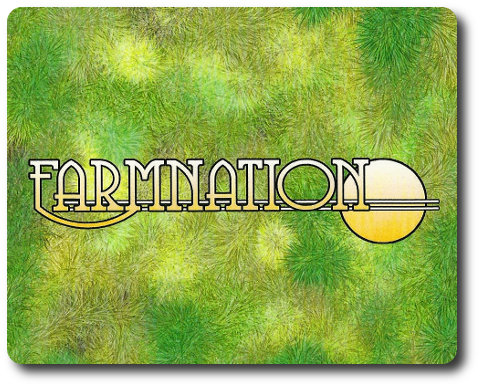
The Basics:
- For ages 4 and up (publisher suggests 8+)
- For 3 to 6 players
- Approximately 30 minutes to complete
Geek Skills:
- Counting & Math
- Logical & Critical Decision Making
- Pattern/Color Matching
- Risk vs. Reward
- Resource Management
Learning Curve:
- Child – Easy
- Adult – Easy
Theme & Narrative:
- It’s not easy being a farmer…
Endorsements:
- Gamer Geek rejected!
- Parent Geek mixed!
- Child Geek approved!
Overview
Will Rogers said, “The farmer has to be an optimist or he wouldn’t still be a farmer.” A rather useful point-of-view in life and for this game. Farming is hard work. The energy you spend today could be wasted effort tomorrow. Bad weather, animals, and insects can ruin a good days work or the family farm. A farmer is continually forced to make tough choices, sacrifice, and hope for the best. You won’t be losing your livelihood in this game, but do stay on your toes. Farmnation is no stroll in the garden.
Farmnation, designed by Michelle Menard and published by Artemic Games via the Game Crafter, is comprised of 189 round tiles (that depict various crops, farmland, water holes, rocks, hoes, fertilizer, hungry bunnies, sly foxes, pesky bugs, and lethal insecticide), 20 Equipment cards (that depict cropduster airplanes, scarecrows, greenhouses, irrigation, and combines), 6 Farm mats (4×4 square grid), and 1 large cloth bag. The illustrations are simple, but do a good job of accurately depicting that which the tile or card is representing. The cards and Farm mats are durable and the tiles are made of solid plastic. The rule book has typos, strange wording, and is missing some details which will most likely confuse you the first time you read it.
Game Set Up
To set up the game, first give each player 1 Farm mat, 2 “Plowed Land” tiles, and 1 “Water Hole” tile. The players now place the starting tiles on their Farm mat. There are only two rules that need to be followed during the initial tile placement.
- All tiles must remain within the 4×4 grid on the Farm mat
- Each tile must be adjacent to another tile
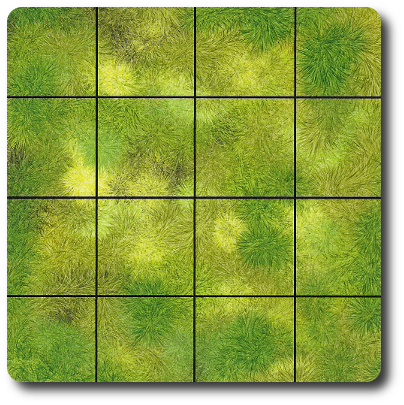
The player’s Farm mat
Second, place all the remaining tiles in the cloth bag. Mix the tiles in the bag and set the bag aside for the moment.
Third, take the Equipment cards and remove 2 of each type if playing with 3 players and 1 of each type if playing with 4 players. The removed Equipment cards are placed back in the game box.
Fourth, make an Equipment card deck and place it face-up in the middle of the playing area. This is the Equipment deck for the duration of the game. It does not need to be shuffled.
That’s it for game set up. Time to do some farming.
About the Tiles
This game has several different types of tiles. They are summarized here.
Water Hole Tiles
These tiles represent a source of water that can be used to irrigate adjacent “Plowed Land” tiles.
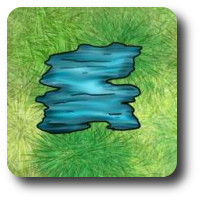
Plowed Land Tiles
These tiles represent open land that can be farmed. However, before a player can plant crops on the land, it needs to be adjacent to a “Water Hole” tile.
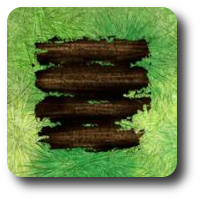
Crop and Fertilizer Tiles
There are a wide variety of crops in the game. All a crop needs to grow is an open “Plowed Land” tile that is adjacent to at least 1 “Water Hole” tile. However, not all crops are created equal. Some take longer to grow and different crops fetch different prices at the market. Each “Crop” tile has an image that depicts the fruit or vegetable it represent, a number that indicates how many other “Crop” tiles of the same type are needed to harvest the crop, and the crop’s worth at the market. Crops range in price from $1 to $5. Fertilizer helps crops grow and acts a “wildcard” in the game, adding to a player’s crop yield.
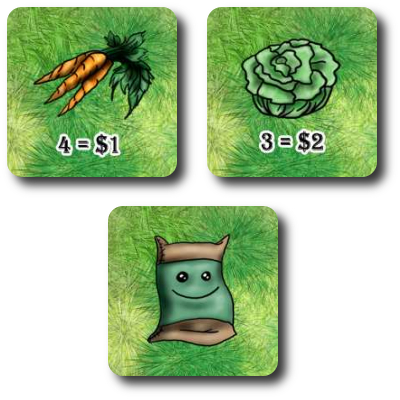
Bug, Bunny, and Rock Tiles
Bugs and Bunnies are a real nuisance and stop a player from harvesting crops until they are removed. Rocks occupy squares on the Farm mat and stop a player from placing any other tile in that spot until the rocks are removed.
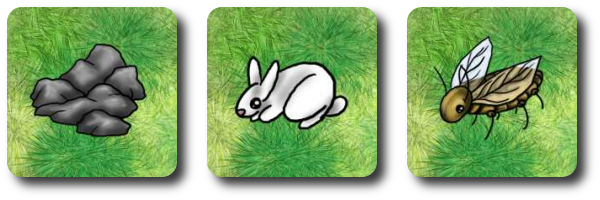
Hoes and Foxes
Hoes are used to remove 1 stack of “Crop” tiles from the Farm mat, freeing up the land for planting. Foxes eat the “Bunny” tiles and remove the cottony threat from the player’s crops. “Insecticide” tiles are used to remove “Bug” tiles.
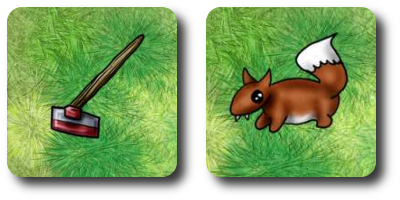
About the Cards
The Equipment cards represent farm improvements that remove threats and reduce various farming challenges permanently. Such improvements come at a cost, however, and the player will have to spend the money earned from sold crops to purchase the equipment. Each Equipment card type is summarized here.
- Cropduster: Permanently protects the player’s land against “Bug” tiles (does the same thing as the “Insecticide” tile)
- Scarecrow: Permanently protects the player’s crops from “Bunny” tiles (does the same thing as the “Fox” tile)
- Greenhouse: Permanently reduces the total yield to harvest a crop by 1
- Irrigation: Permanently waters all the player’s land, making the “Water Hole” tile no longer necessary
- Combine: Permanently protects the player’s land from “Rock” tiles
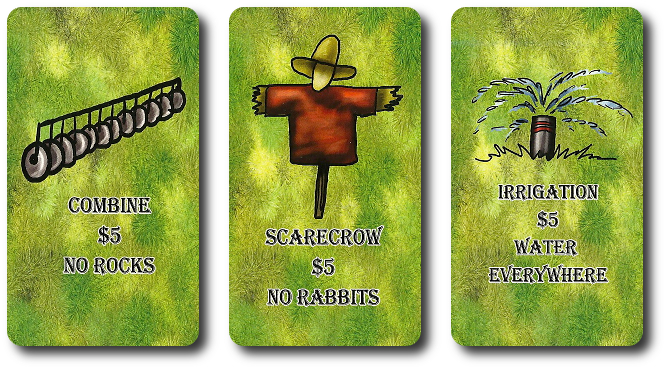
Working the Land
Farmnation is played in turns with no set number of turns per game. On a player’s turn, they must complete 1 action and have the option of taking 2 more. The order in which the player takes the actions is up to them.
Mandatory Action: Draw and Place One Tile
The player must blindly draw 1 tile from the bag on their turn and place it on their Farm mat or on an opponent’s Farm mat. It’s the player’s choice, but the tile must be placed where possible. This means a player might have to place a beneficial tile on an opponent’s Farm mat and be forced to play a harmful tile on their own Farm mat. If the tile cannot be placed, it is removed from the game.
When placing a tile, a few rules apply.
- “Plowed Land” tiles can be placed on any unoccupied square on the Farm mat, but must be adjacent to another tile
- “Water Hole” tiles can be placed on any unoccupied square on the Farm mat, but must be adjacent to another tile
- “Rock” tiles can be placed on any unoccupied square on the Farm mat (farms that have the “Combine” Equipment card are protected), but must be adjacent to another tile
- “Fertilizer” tiles can be placed on any “Crop” tile stack and contributes to its total yield
- “Bunny” tiles can be placed on any “Crop” tile stack (farms that have the “Scarecrow” Equipment card are protected)
- “Bug” tiles can be placed on any “Crop” tile stack (farms that have the “Cropduster” Equipment card are protected).
- “Crop” tiles can be placed on any unoccupied “Plowed Land” tile that is adjacent to a “Water Hole” or on a “Crop” tile stack of the same type.
A player can also “uproot” a “Crop” tile stack on their Farm mat if they draw a “Crop” tile that potentially could make more money or they do not want to give away. Uprooting can only be done on the player’s mat (no fair uprooting an opponent’s crop) and only when a “Crop” tile is drawn. The uprooted “Crop” tiles are discarded and the new “Crop” tile takes the now vacant “Plowed Land” tile space.
There are a few tiles that remove other tiles from Farm mats, but are not placed. When used, they are discarded for the duration of the game.
- “Fox” tile removes all “Bunnies” from one Farm mat ( both the “Fox” and “Bunny” tiles are discarded)
- “Insecticide” tile removes all “Bugs” from one Farm mat (both the “Insecticide” and “Bug” tiles are discarded)
- “Hoe” tile removes 1 stack of “Crop” tiles from the Farm mat (the “Plowed Land” tile remains)
Note: In all cases, the player MUST play the tile they drew by placing it on their Farm mat or their opponents Farm mat. It’s only discarded if it’s impossible to play the tile. The player does not get to draw a new tile if such is the case.
Optional Action: Harvest
A player may choose to harvest one or more crops from their Farm mat if the yield has been met for the “Crop” tile. Each “Crop” tile has a number value that represents the yield and a proceeding number that shows the price of the crop once it’s harvested. If the player has a number of “Crop” tiles stacked equal to or greater than the yield shown on the “Crop” tile, it can be harvested.
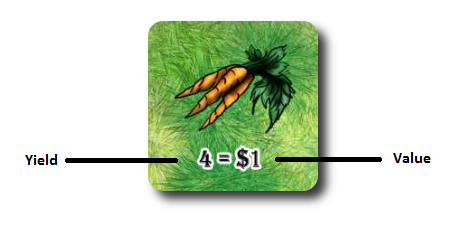
When harvesting, all but one of the “Crop” tiles are removed from the game. If the “Fertilizer” tile was used to help meet the crop’s yield, it’s also discarded. The player then takes the one “Crop” tile that they kept and places it in front of them, making sure to keep it off their Farm mat. The “Plowed Land” tile is now unoccupied and ready for planting. No bonuses are provided to players who harvest crops that have a yield higher than necessary. For example, a player who harvests the “Tomato” tile stack that has a yield of 4, but is comprised of 7 tiles, still only keeps one tile and will discard the other 6. In this game it doesn’t pay to grow big.
Note: A player could harvest before they place a tile. This could save them from giving a beneficial tile away. However, a player can only harvest on their turn.
Optional Action: Buy and Trade Equipment
On their turn, and only on their turn, the player may buy Equipment cards and attempt to sell them. There are only so many Equipment cards to go around and a savvy player might be able to sell a piece of equipment for more than what it’s worth. All buying and selling of Equipment cards is done using the harvested “Crop” tiles. The dollar amount on the “Crop” tile represents how much “cash on hand” the player has.
Buy From Equipment Deck
The player picks up the Equipment deck and looks through it to find the Equipment card they want to purchase. They place the card face-up in front of them and then pay for the piece of equipment using their harvested “Crop” tiles. The player MUST be able to pay the total amount listed on the Equipment card using one or more of their harvested “Crop” tiles. No change is provided if the player pays over. “Crop” tiles used as payment are discarded for the duration of the game and the “Equipment” card comes immediately into play.
Sell to Opponent
If the player and an opponent can come to an agreement, an Equipment card can be sold for an agreed upon price. Like buying from the Equipment deck, the opponent MUST be able to pay the total amount agreed upon for the Equipment card using one or more of their harvested “Crop” tiles, however the player who is selling the Equipment card KEEPS the “Crop” tiles used as payment. Both the player and the opponent can come to an arrangement where “making change” is concerned. The newly acquired Equipment card comes immediately into play for its new owner.
This ends the player’s turn. The next player in turn order sequence now goes.
End of the Farming Season
The game ends when the last tile is drawn and the player who drew it completes their turn. Points are now counted to determine the winner. Only harvested “Crop” tiles are scored. Add the money values of each together to determine a player’s final score. Equipment cards and any tiles on the player’s Farm mat are not scored. The player with the most points is the winner of the game.
Game Variants
A number of game variants are provided in the rule book. They are summarized here.
- For a faster game, have players draw 2 tiles on their turn.
- For an easier game, allow “Water Holes” to irrigate “Plowed Land” tiles on any of the 8 squares that surround it.
- For a more difficult game, “Bug” and “Bunny” tiles remove the top most “Crop” tile from play and then occupy the “Crop” tile stack as normal.
- Create one really big communal farm and place the Farm mats together (1 per player). All players play to the same farm and compete to harvest the fastest. Equipment cards are removed from play.
House Rules
Healthy Growth
None of the players liked that you couldn’t work on a “Crop” tile stack to deliver a higher payout. We changed the rules slightly to allow this. A “Crop” tile stack must still meet its yield, but any “Crop” tiles on the stack that are over the yield are kept. For example, a “Carrot” tile has a yield of 4. If the “Crop” tile stack had 8 “Carrot” tiles on it when it was harvested, the player would keep 5. This house rule gives the players the option to obtain more money, but at a risk. When other players see an opponent with a huge yield, they could sabotage it with a “Bunny”, “Bug”, or “Hoe” tile.
A Useful Hoe
All of our players were pretty frustrated they didn’t have the ability to easily remove “Rock” tiles from their Farm mat without the help of the “Combine” Equipment card. We solved this by allowing the “Hoe” tile to remove 1 “Rock” tile from a Farm mat or removing 1 “Crop” stack. Additionally, if you remove a “Crop” stack with a “Bug” or “Bunny”, they are also removed from the game.
To learn more about Farmnation, visit the game’s web page.
Prediction
I have always enjoyed Farming games. I have no farming background and I dislike gardening. And yet, I’ll happily sit down to a game that allows me to grow plants, raise animals, and manage a farmstead. I even married a farmer’s daughter and have a giant farm behind my house. Coincidence? Perhaps…
Farmnation appears to be an exceedingly light and fast version of a larger farming simulator. All the things that I like about such games appear to be included. For example, resource management, risk management, and economic decision making. What I don’t think will be liked by many of our players is the game’s randomness. You can’t run an efficient farm if the choices you are given to act upon are always randomly determined.
For the Child Geeks, I think Farmnation will do well. The game doesn’t appear to be overly difficult to learn and the choices a player needs to make are always based on the tile they drew. They will most likely get upset if they feel picked on by their opponents, which is something we are always sensitive to. The Parent Geeks might enjoy this game and might not. The randomness and inability to take immediate action on harmful tiles placed on their Farm mat is going to cause frustration. If it causes too much frustration, the game will fail to impress. As for the Gamer Geeks, I don’t think they are going to enjoy this game at all. It’s too random and it would appear to be very difficult to devise any meaningful strategy and tactics.
Teaching Farmnation is best done by taking a Farm mat and demonstrating how the tiles work. There are not that many types to discuss. Best of all, this is a game you can teach as you play it. Set the game up and hand the bag to the first player. After they draw their first tile, explain to them what they can do with it. I’ve tried both teaching methods and both work equally well. Note that this game uses pictures for the most part, but the younger Child Geeks will need help with the math.
And so, after teaching the game to all 3 of my little geeks, I asked them their thoughts on Farmnation so far.
“I like the concept of the game. Should be interesting.” ~ Liam (age 9)
“Easy rules, easy to understand, and giant bugs. What’s not to like?” ~ Nyhus (age 10)
“Can I eat the vegetables?” (Makes sounds like he is eating the “Crop” tiles) ~ Ronan (age 4)
My little geeks are interested and I’m itching to get the game going. Let’s play Farmnation and see if it makes farming fun.
Final Word
The Child Geeks mostly enjoyed the game, especially when they were able to harvest their crops or skunk their opponents with a plague of ravenous bunnies or swarms of bugs. They were frustrated when they couldn’t draw the tile they needed and overjoyed when an opponent gave them a tile they could use. They didn’t purchase Equipment, but did go out of their way to uproot cheap vegetables when more expensive ones were drawn. Overall, I would say the Child Geeks played the game well, but their strategy and tactics failed to grant them victory. You can’t really “plan” in this game. The best you can do is take measures that reduce your odds of being sidetracked. The Child Geeks didn’t do much of this. They preferred to take action on each tile they drew and thought little of how it impacted their long-term goals. According to one Child Geek, “I like how fast this game plays, but I don’t like that I can’t find the crop I need.” Another Child Geek said, “I hate bugs and bunnies now.” When all the games were over, the Child Geeks voted to approve Farmnation.
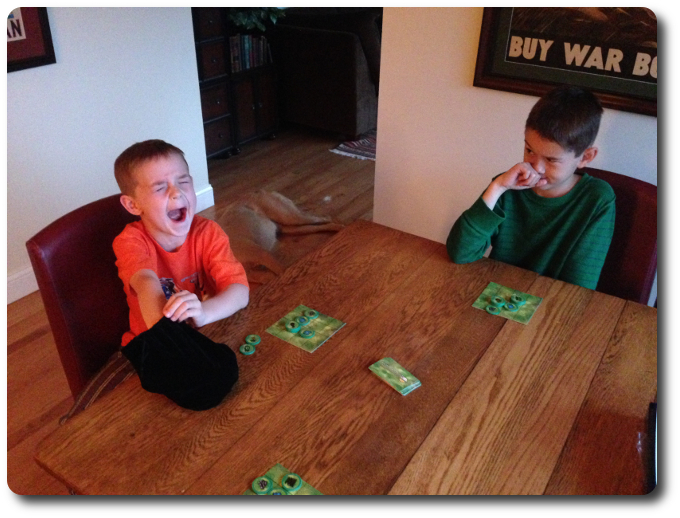
One of my little geeks concentrates (very hard) while randomly pulling a tile – it didn’t help
The Parent Geeks were not thrilled about how often they drew tiles they couldn’t use or didn’t want to giveaway. According to one Parent Geek, “What I like about this game is how fast it plays, which is a very good thing, when you consider how difficult it can be at times to get what you need.” Another Parent Geek said, “This is a very frustrating game. I can’t seem to get a land or water tile. I guess I”m going to lose the family farm.” All the Parent Geeks understood how to play the game, but were continually disappointed and frustrated with how the game played out. Too much randomness and luck continued to cast a dark cloud over the gaming table, but there were a good number of Parent Geeks who enjoyed the game, as well. According to one Parent Geek, “I think the game does a good job of keeping players on task, engaged, and thinking. What’s not to like about that?” When all the games were over, the Parent Geeks had mixed feelings about Farmnation. Some liked it, some didn’t, and most thought it was just an “OK” game.
The Gamer Geeks were very frustrated with this game. According to one Gamer Geek, “It’s a good idea, but doesn’t work. It’s too random and I am not able to work towards a specific goal. I don’t like that.” Another Gamer Geek said, “I thought this could be like Carcassonne when you first explained it, but now I see it is more like CarcaCAN’T!”. The Gamer Geeks did like how each tile had to be played, but quickly saw that all this did was lock up players even more. One Gamer Geek said, “Great. I just pulled a “Plowed Land” tile that I’ve been looking for, but I’ve got rocks everywhere. Thanks, guys.” Fields went unplowed, crops failed to grow, and harmful creature ran about unchecked. Farmnation didn’t win any friends at the Gamer Geek’s gaming table.
This game leaves me with mixed feelings. I very much enjoy how easy it is to play the game, the light resource management aspects, the ability to place tiles on your opponent’s farms, and the risk management that is necessary to keep the family farm prosperous. What I don’t care for is the random draw of tiles that often leave you with something you cannot use yet, often being “gifted” a tile by an opponent that just slows you down, and the inability to devise a strategy to win. It’s a strange mix of fun and frustration.
Many of our players commented on the inability to draw a tile they needed. This is a valid point as there are 189 tiles in the game. The odds of a player drawing the exact tile they require is slim, but probable. The game addresses this by forcing players to play a tile on an opponent’s farm if the player is unable or doesn’t want to play it to their own farm. You’d think this would solve all the issues, but it just opens the door to more trouble. For example, my Farm mat was littered with “Rock” tiles given to me by opponents and I was forced to farm a very small portion of the farmland as a result.
And yet, there were some games were I or other players were being overwhelmed with positive tiles. Not to worry. Individual players who seemed to be too lucky, quickly fell victim to their overly unlucky opponents’ jealousy. Farming, as it turns out, is a dirty business.
This is where the Equipment cards come into play. They make certain some tiles are no longer a concern and reduce the requirements to score points. Of course, you have to spend points to buy the Equipment cards which many player didn’t want to do. It’s difficult to rationalize the purchase of equipment when you are having a difficult time growing the crops that would use it. For the Child Geeks, this was a concept that escaped them. The Parent Geeks and Gamer Geeks understood this very well, but loathed spending their points midway through the game. In some respects, the speed of the game hurts itself and forces the players to “react” to the game’s randomness rather than taking “action” to curb it.
The trick to this game is to diversify your farm and prepare for inconsistency and randomness the best you can by buying equipment that forces certain tiles to no longer be valid or required. This, in turn, makes the player’s farm slightly more efficient, but not more profitable. Players still have to draw on their turn, do not automatically generate needed tiles, and are still susceptible to the fickleness that is luck. Most of the time players are going to feel like they are the world’s most incompetent farmer when they can’t even plow a field or take care of one dumb bunny. One could also say that Farmnation is the perfect farming simulation. If you just woke up one day and decided, “Hey, I’m going to be a farmer!”, then Farmnation would be the real world result.
This is a light game, doesn’t take long to play, and gives players the ability to devise strategy and tactics, but seldom the opportunity to use them. Most of the time, victory is going to depend on luck and logical thinking. If you are looking for a Farming game that is easy to play and doesn’t take long, then do take a look at Farmnation. If nothing else, this games will justify your life choices not to become a farmer.
This game was given to Father Geek as a review copy. Father Geek was not paid, bribed, wined, dined, or threatened in vain hopes of influencing this review. Such is the statuesque and legendary integrity of Father Geek.




Pingback: In Review: Father Geek’s Monthly Newsletter (July 2014) - Father Geek
Pingback: In Review: Father Geek’s Monthly Newsletter (August 2014) - Father Geek